Common menu bar links
Breadcrumb Trail
ARCHIVED - Fisheries and Oceans Canada
 This page has been archived.
This page has been archived.
Archived Content
Information identified as archived on the Web is for reference, research or recordkeeping purposes. It has not been altered or updated after the date of archiving. Web pages that are archived on the Web are not subject to the Government of Canada Web Standards. As per the Communications Policy of the Government of Canada, you can request alternate formats on the "Contact Us" page.
Minister's Message

As Minister of Fisheries and Oceans, I am pleased to present my Department's Report on Plans and Priorities for 2010-11.
Fisheries and Oceans Canada (DFO) is a national and international leader in the management of oceans and freshwater resources, as well as marine safety. As a sustainable development department, DFO integrates environmental, economic, and social perspectives to ensure Canada's oceans and freshwater resources benefit this generation and those to come. Our work on Canadian waters helps to ensure the safe passage of people and goods.
As we emerge from the global economic downturn, our Department is taking action to ensure that Canada's fisheries and maritime sectors will provide economic benefits to Canadians now and in the future. We are helping these sectors to become more resilient, flexible, competitive, and prosperous.
Canada's Economic Action Plan is already protecting Canadians, stimulating our economy, and creating jobs throughout Canada. Under the Plan, we are providing additional funding for vital fisheries and marine infrastructure, as well as support for coastal communities affected by the economic downturn. To reach these goals, DFO is sharpening its focus on several priorities for 2010-11.
Improving the Economic Viability of Canada's Fisheries
Sustainable fisheries and aquaculture make a significant contribution to Canada's economy. One of the greatest challenges we face is ensuring that consumers have more accurate information about the seafood they buy.
We are working closely with industry stakeholders to help them obtain the certification needed to expand access to markets at home and abroad. We will continue investing in aquaculture innovation and aquatic animal health and improving the predictability of regulations. These efforts will help protect and expand access to domestic and foreign markets. Around the globe, consumers are demanding fish and seafood that is not only safe and healthy but also fished in a way that does not threaten fish stocks or harm the marine environment. Our government's objective is to ensure that Canada is a world leader in sustainable fish and seafood products. That is why DFO is working to ensure healthy and productive aquatic ecosystems — they form the basis of sustainable fisheries. Using sound science, we are managing environmental impacts, imposing conservation measures, enforcing regulations, and monitoring results to protect and conserve fish stocks.
We must also ensure support for the food, social, and ceremonial needs of First Nations, as well as for recreational fisheries, which are critical to the Canadian economy.
We understand that a successful commercial fishery relies on a well-functioning network of small craft harbours across Canada. Under Canada's Economic Action Plan, DFO will invest the second year's portion of the original $200 million to revitalize small craft harbours across the country. By investing in the maintenance and repair of these core commercial fishing harbours, we are creating jobs for Canadians and investing in coastal and inland communities. One of our priorities is building a commercial fishing harbour in Pangnirtung, Nunavut, to boost the viability of the Northern fishery.
Many Aboriginal and Inuit people, along with residents in remote Atlantic communities, include seal hunting as part of their cultural heritage, as well as a source of food, raw material and income. Our government recognizes the seal hunt is a vital component of their local economies. Our commitment to the long-term sustainability and profitability of the seal harvest is strong. We want it to continue to provide important economic opportunities for our remote coastal and northern communities, and we will maintain our active promotion of seal products in new markets around the world.
Using science as our foundation, we are working with partners around the world to ensure the conservation and protection of the valuable marine resources found in international waters. Canada continues to be a leader in international efforts to combat illegal, unreported, and unregulated fishing through our membership in Regional Fisheries Management Organizations, including the Northwest Atlantic Fisheries Organization.
Enhancing Marine Safety and Security through Fleet Renewal
The dedicated men and women of the Canadian Coast Guard (CCG) continue to uphold the safety of our waters. Safe and accessible waterways facilitate marine commerce, including international trade and the economic benefits of recreational boating.
Under Canada's Economic Action Plan, we are modernizing the CCG fleet. With the second year's portion of the $175 million, Coast Guard will procure 68 new small vessels and 30 environmental barges and undertake repair work on 40 of its aging large vessels. We are also supporting our government's goals for security and sovereignty under the Northern Strategy. In support of this priority, we are replacing the CCG vessel Louis S. St-Laurent with a new polar icebreaker, the John G. Diefenbaker, which will be delivered in 2017.
Also supporting marine safety, security, and sovereignty is DFO's Canadian Hydrographic Service (CHS). CHS surveys Canadian waters and produces hydrographic products and services for mariners and information to support national security, emergency preparedness, and the resolution of boundary disputes. To affirm our sovereign rights to Canada's continental shelf beyond the existing 200 nautical mile limit, CHS is on target to complete the necessary hydrographic work and assist in the preparation of Canada's submission to the United Nations Commission on the Limits of the Continental Shelf in 2013.
Ensuring Sustainable Development of our Fisheries and Oceans
DFO protects aquatic ecosystems so that Canadians have fisheries resources for Aboriginal, commercial, and recreational use now and in the future. Through strong habitat management, our Department helps the natural resource development sector mitigate and avoid impacts on precious fish habitat. Fulfilling our responsibilities under the Species at Risk Act enables us to preserve the biodiversity of our aquatic ecosystems.
Through our comprehensive science program, DFO supports the evolution of sustainable aquaculture — improving nutrition, health, and production while reducing the impacts on aquatic environments.
Our Department is also creating new oceans centres of expertise to broaden our knowledge of Canada's waters. We will continue to expand our network of Marine Protected Areas and develop ecosystem monitoring strategies for boundary waters in our Arctic.
The recent announcement of the Commission of Inquiry into the Decline of Sockeye Salmon in the Fraser River illustrates the importance of managing fish stocks. Our Department will be working closely with the Commission to help advance its work, improve our understanding of the state of the Fraser River sockeye, and determine what can be done to effectively restore and conserve the stock.
Improving our Effectiveness through Collaboration
DFO is taking a community-based and co-operative approach to managing our fisheries and oceans.
We will continue to forge strong relationships with industry, non-governmental groups, fishers' unions, Aboriginal communities, and our government partners.
Our Department is modernizing human resource management, developing a new strategy for information management, and strengthening the management of its considerable infrastructure.
By working together with Canadians, we will build strong, sustainable fisheries and maritime sectors for future generations.
The Honourable Gail Shea, P.C., M.P.
Minister of Fisheries and Oceans
Section 1 – Departmental Overview
Raison d'être
Fisheries and Oceans Canada (DFO) plays the lead role in managing Canada's fisheries and safeguarding its waters, ensuring safe, healthy, and productive waters and aquatic ecosystems for the benefit of present and future generations. The Department's work is built around three strategic outcomes:
Safe and Accessible Waterways
Providing access to Canadian waterways and ensuring the overall safety and integrity of Canada's marine infrastructure for the benefit of all Canadians;
Sustainable Fisheries and Aquaculture
Delivering an integrated fisheries and aquaculture program that is credible, science-based, affordable, and effective and contributes to sustainable wealth for Canadians while respecting Aboriginal and treaty rights; and
Healthy and Productive Aquatic Ecosystems
Ensuring the sustainable development and integrated management of resources in or around Canada's aquatic environment and carrying out critical science and fisheries management activities.
Mandate
DFO is responsible for developing and implementing policies and programs in support of Canada's scientific, ecological, social, and economic interests in oceans and fresh waters.
The Canadian Coast Guard (CCG), a Special Operating Agency within DFO, is responsible for services and programs that contribute to the safety, security, and accessibility of Canada's waterways. CCG supports other government organizations through the provision of a civilian fleet and a broadly distributed shore-based infrastructure.
The Oceans Act entrusts the Minister with leading integrated oceans management and providing coast guard and hydrographic services, while the Fisheries Act gives the Minister responsibility for the management of fisheries, habitat, and aquaculture. The Species at Risk Act gives the Minister responsibilities associated with the management of aquatic species at risk.
Our Vision
Excellence in service to Canadians to ensure the sustainable development
and safe use of Canadian waters.
Organization
Fisheries and Oceans Canada is a highly decentralized department, with more than eight of every ten employees located outside national headquarters. National headquarters, in Ottawa, establish national objectives, policies, procedures, and standards for the Department and CCG.
DFO's Regions
In addition to the National Capital Region (NCR), which serves as the Department's national headquarters, DFO has six regions, each headed by a Regional Director General (RDG).
Situated in regional headquarters, RDGs are responsible for delivering programs and activities in their regions in accordance with national and regional priorities and within national performance parameters. The Department operates 15 major science institutes, laboratories, and experimental centres across the country.
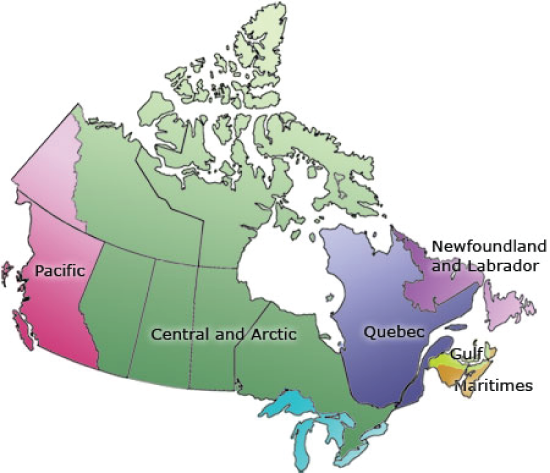
- The Newfoundland and Labrador Region encompasses over 29,000 kilometres of coastline and three international boundaries. Work is performed from 30 offices throughout the region, and headquarters are located in St. John's, Newfoundland.
- The Gulf Region comprises the waters of the Gulf of St. Lawrence adjacent to the eastern coast of New Brunswick, the Northumberland Strait coast of Nova Scotia and western Cape Breton Island, as well as the whole of Prince Edward Island. It is the only region of DFO, outside the NCR, that is designated bilingual. Regional headquarters are in Moncton, New Brunswick, and there are three area offices. Program delivery is supported by 20 field offices.
- The Maritimes Region extends from the northern tip of Cape Breton to the New Brunswick-Maine border, taking in over 8,600 kilometres of coastline and adjacent marine areas, including the Bay of Fundy. Regional headquarters are in Dartmouth, Nova Scotia. There are also three area offices — in Yarmouth, Nova Scotia; Sydney, Nova Scotia; and St. Andrews, New Brunswick — and more than 100 other sites.
- The Quebec Region, located within the borders of the province of Quebec, has 6,000 kilometres of coastline. The Quebec Region has a staff of more than 1,000 employees in some 15 cities and villages. Most programs and activities are managed from the regional office, in Québec.
- DFO's largest geographic region, Central and Arctic, extends west from the Quebec Region to British Columbia's eastern border — excluding the National Capital Region — and up through Canada's far North. The region includes 71% of Canada's coastline, 67% of its fresh waters, 65% of its marine waters, 64% of its area, and 55% of its population. Central and Arctic is home to five major research facilities: the Freshwater Institute Science Laboratory, the Bayfield Institute, the Sea Lamprey Control Centre, the Experimental Lakes Area, and the Resolute Bay Laboratories.
- Pacific Region has over 27,000 kilometres of coastline and hundreds of aquatic species to protect, manage, and enhance. The region is responsible for overseeing West Coast marine resources and the inland fisheries of British Columbia and the Yukon. As the Pacific Region is entrusted with managing and protecting Pacific salmon, it plays a role in the stewardship of 105 river systems in British Columbia and two transboundary northern rivers, the Stikine and Taku.
Canadian Coast Guard — DFO's Special Operating Agency
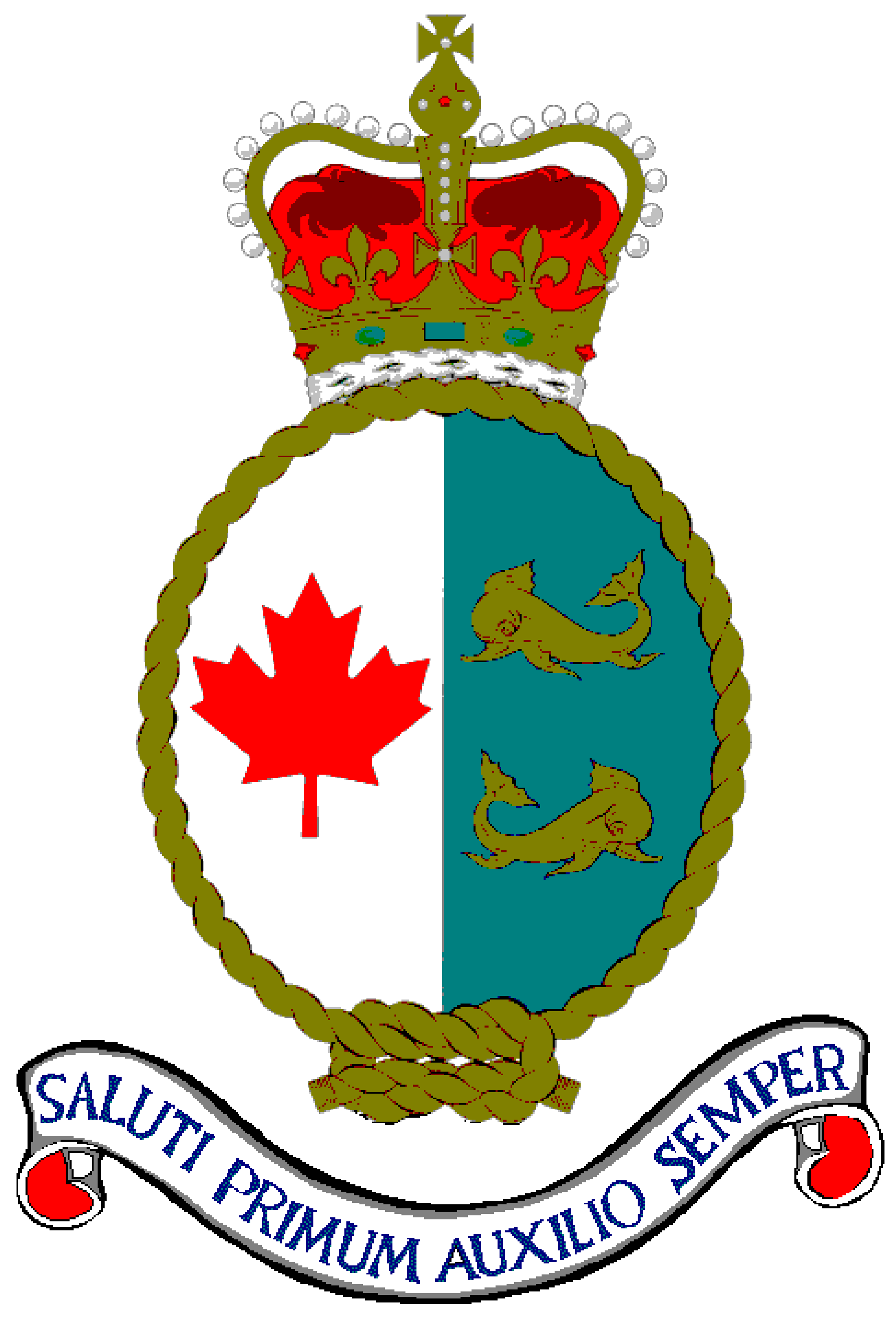
The Canadian Coast Guard is a Special Operating Agency (SOA) within DFO. The Agency's headquarters are in the National Capital Region, and there are five regional offices. Like the rest of DFO, CCG is highly decentralized, with 92% of its employees located in the regions. Because CCG is an operational organization, many programs and services are provided 24 hours a day, seven days a week.
The Commissioner is the Chief Executive Officer of the Agency, reporting and accountable to the Deputy Minister of Fisheries and Oceans Canada for the performance of the Coast Guard. Each CCG region is led by an Assistant Commissioner, who reports to the Commissioner and is responsible for directing the day-to-day delivery of CCG programs and services in that region. While CCG plans at a national level to ensure consistency in the design and delivery of programs, the regions are responsible for program delivery.
Coast Guard delivers the following core programs in accordance with published levels of service and service standards in each of its five regions: Aids to Navigation, Waterways Management, Marine Communication and Traffic Services, Search and Rescue, Environmental Response, and Icebreaking (except in Pacific Region). The CCG fleet delivers many of these programs and supports DFO's science and conservation and protection activities, as well as the on-water needs of other government departments. The Canadian Coast Guard College, in Sydney, Nova Scotia, trains and develops marine professionals to support CCG-mandated programs.
CCG is committed to ensuring that its programs and services are aligned with the needs and expectations of its clients, stakeholders, and the Canadian public. The Agency has a number of consultative mechanisms in place at both the regional and national level to ensure that these views and needs are incorporated into Coast Guard program planning and decision-making.
While all five regions deliver the core CCG programs, the focus in each region is different, depending on climate, geography, and client needs. For example:
- Newfoundland and Labrador Region, with the largest oil-handling port in Canada, a rapidly expanding offshore oil industry, and millions of tons of potentially polluting cargo and vessel fuel transiting its waters each year, must always be ready to protect the marine environment.
- Maritimes Region operates the Canso Canal on a 24-hour basis each year from April 16 to December 23, linking Chedabucto Bay to Northumberland Strait. Sailing through the Strait via the Canso Canal benefits the commercial shipping and fishing industries by reducing transit time and fuel costs.
- Quebec Region delivers aids to navigation, channel maintenance, and icebreaking services that help to keep the St. Lawrence River up to Montreal open and accessible throughout the year for the benefit of commercial shipping and Canadians in general.
- Central and Arctic Region's partnership with the United States Coast Guard in the delivery of the icebreaking and aids to navigation programs on the Great Lakes provides the marine industry with a fully integrated, bi-national service. The region also provides support to Eastern Arctic sealift activities for the Government of Nunavut.
- Pacific Region, with 27,000 kilometres of coastline and 560,000 square kilometres of ocean, attracts approximately 750,000 vessel movements a year. Ensuring the safety of these movements is challenging, as weather can vary dramatically and be very severe along the British Columbia coast.
The implementation of the government's Economic Action Plan is affecting each CCG region, providing $175 million over two years for the procurement of new small vessels and major repair work on large vessels. This investment will help CCG to maintain its service levels on Canada's three coasts, the Great Lakes, and the St. Lawrence Seaway.
More information on Coast Guard plans and priorities can be found in Section 2 of this report and in the CCG Business Plan, which is available on the CCG website.
Program Activity Architecture
The Government of Canada's Management, Resources and Results Structure (MRRS) is the foundation of a common, government-wide approach to the collection, management, and reporting of financial and non-financial information. DFO's Program Activity Architecture (PAA) is a component of its MRRS. The PAA shows how DFO's programs align with the Department's three strategic outcomes. Each Program Activity is linked to a single Government of Canada Outcome Area, permitting whole-of-government reporting.
The PAA also captures the functions that enable public programs, as well as internal services, to operate more effectively and efficiently. These functions are called Internal Services. For more information see DFO's Internal Services.
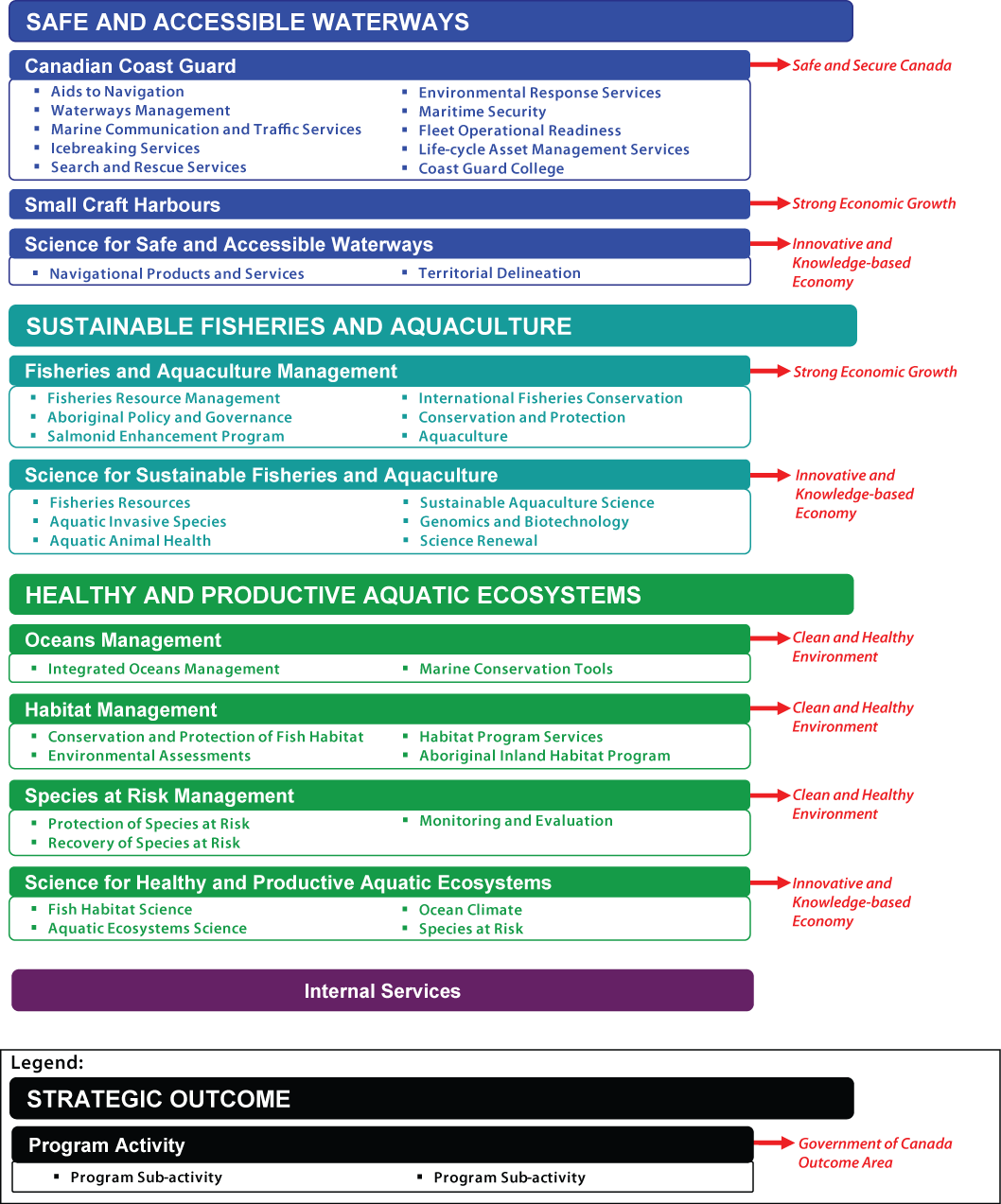
[Program Activity Architecture]
Changes for 2010-11
DFO's PAA for 2010-11 differs only slightly from 2009-10. The Department's strategic outcomes and program activities remain unchanged. Changes have been made at the sub-activity and sub-sub-activity level only.
The names of three sub-activities have changed to better reflect their responsibilities.

[Program Activity Architecture: Changes for 2010-11, Number 1]
Two sub-sub-activities have been added to the Aboriginal Policy and Governance sub-activity. These sub-sub-activities were previously included within the Aboriginal Fisheries Strategy sub-activity.
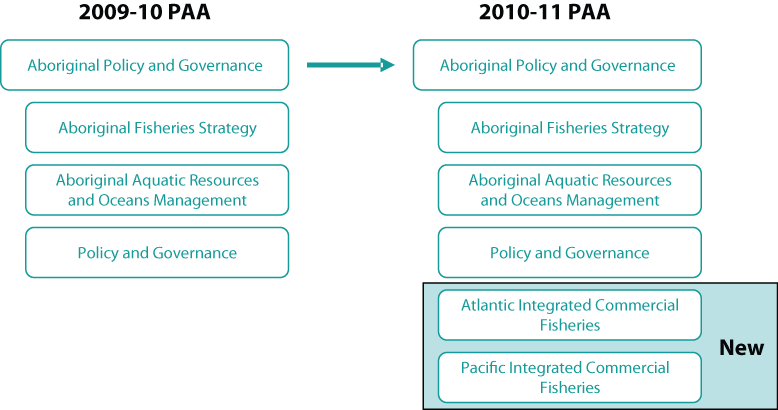
[Program Activity Architecture: Changes for 2010-11, Number 2]
Looking ahead to 2011-12
DFO is redesigning its Management Resources and Results Structure (MRRS) for 2011-12. The main goals of the redesign are to better reflect the departmental mandate and to ensure all MRRS components are fully compliant with Treasury Board Secretariat's Policy on MRRS.
Strategic Context
To provide Canadians with the benefits of strong economic growth, knowledge and innovation, healthy environments, and safe and secure communities, DFO must evaluate an increasingly complex and demanding policy and program environment that is characterized by interdependent domestic and global issues and risks.
The Economy
Canada's marine economy is growing. Our oceans and waterways are experiencing rapid expansion and economic potential related to shipping, oil and gas exploration, and tourism (e.g., ecotourism, cruise ships, and recreational boating). There are also numerous opportunities for new and emerging sectors (e.g., offshore renewable energy, sea-bed mapping and mining, biotechnology, and marine engineering and construction). Increasing demands for resources offer new scope for oceans and seafloor resources, particularly in Canada's North.
Canada's aquatic environment provides excellent conditions for natural and farmed fish harvesting. This harvesting capacity contributes to economic prosperity for Canadians through the generation of wealth from commercial, recreational, aquaculture, and Aboriginal fishing interests.
Changing climatic conditions in Canada's North provide both opportunities for Northern economic development and challenges to the protection of the ecosystem and its users. Sea-ice depletion offers the prospect of new navigation routes in Canada's North, bringing about a need for new hydrographic data and navigational charts, new harbour facilities, and an increased CCG presence to provide search and rescue and emergency environmental response. Increased use of our northern waters makes the protection of their fragile and unique ecosystems paramount.
Canada's Economic Action Plan has presented DFO and CCG with an opportunity to strengthen critical program infrastructures — small craft harbours, the CCG fleet, and scientific facilities — while stimulating economic growth in Canada.
International Issues
Growth that relies on an increasingly global economy necessitates effective international governance mechanisms that ensure sustainable fisheries, healthy oceans ecosystems, and a stable trading regime. Safe and accessible waterways, modern navigation aids, hydrographic products and services, reliable small craft harbours, and collaborative partnerships with domestic and international stakeholders all contribute to these objectives.
Canada's seafood sector is heavily reliant on international trade. A globally competitive fishery must anticipate and adapt to increasingly restrictive global markets and increasing competition from lower cost international processors. With increasing costs of fishing, increasing competition for scarce wild resources, and a growing focus on sustainability, there is a growing reliance on aquaculture to help meet increasing global demand for seafood products. This presents opportunities for Canadian aquaculture but also raises challenges for managing biodiversity. DFO will work with other federal departments, provincial and territorial governments, industry, the private sector, and non-government organizations to increase consumer confidence in aquaculture products, ensure the protection of natural species, and reduce international barriers to Canadian aquaculture products.
A sound strategy with regard to international engagement will allow Canada to work with other nations to protect shared resources.
The Environment
Rising production and consumption of aquatic resources and the increasing intensity and range of ocean use — off-shore oil and gas deposits, mineral resources, hydro development, and undersea cables and pipelines — are placing increased pressures on the biodiversity of living marine resources in oceans. Continental shelf delineation, marine ecosystem protection, and environmental protection are key to DFO's mandate, particularly in Canada's North, where these demands and the effects of climate change have been most noticeable.
Sustained use of our aquatic resources necessitates a thorough understanding of the resources and the ecosystems within which they exist, robust conservation and protection measures, and effective environmental response to emergencies. Continued work on the identification, protection, and recovery of species at risk is essential to maintaining the integrity and biodiversity of our aquatic ecosystems and the sustainability of our resources.
Environmental impacts of climate change include changes in sea levels, changes in water characteristics (e.g., currents, salinity, and temperature), and diminishing ice cover. While this offers possibilities for emerging fisheries and off-shore natural resource development, it also presents risks to habitats, ecosystems, and infrastructure and increases the threat posed by invasive aquatic species. The development of the Arctic's rich resource base requires both a broader scientific understanding and the protection of these unique ecosystems. These impacts are also expected to place increased demands on the Canadian Coast Guard Program, including Icebreaking, Search and Rescue, Environmental Response, and Waterways Management services.
A safe marine environment and the provision of maritime services to Canadians and other federal departments and organizations helps to provide safe and secure communities and Northern development and to demonstrate our Canadian sovereignty. To provide service to Canadians, the Department, and others, the Canadian Coast Guard must now focus on ensuring that it maintains a versatile fleet and shore-based infrastructure.
Science and Technology
New technologies and their application continue to enable and shape the delivery of the Department's mandate. Newer technologies used to observe the oceans, such as satellites, cabled seafloor observation systems, and ocean profiling floats present new opportunities to increase our understanding of global ocean dynamics and processes. Detailed, high-resolution imagery of seafloor substrate, habitat, topography, and geology has proven extremely useful in the delineation of Marine Protected Areas, the exploration and discovery of oil and gas deposits, the identification of safe corridors in which to lay cables and pipelines, and the sustainable management of the fisheries resource. New technology capable of integrating tide, current, and weather data with seabed shape and depth information is making possible near-real-time dynamic navigation systems that allow mariners to see safe navigation channels open up and widen in near-real- time as tides rise and water depth increases. In addition to fulfilling our regulatory responsibilities, biotechnology and genomics applications in support of the Department's mandate will continue to evolve beyond current applications as the technologies' full capabilities are realized.
Departmental Priorities
DFO is committed to supporting environmentally sustainable and internationally competitive marine, fisheries, and aquaculture sectors; healthy aquatic ecosystems; and maritime safety and security. To respond to the potential risks and opportunities related to meeting this commitment, the Department will focus on the following operational priorities over the three-year planning period starting in 2010-11.
| Globally Competitive Fisheries | International Leadership |
|---|---|
| Health of the Oceans | Northern Strategy |
| Fleet Renewal | Regulatory Improvement (Streamlining) |
| Economic Action Plan | Implementing e-Navigation in Canada |
The tables below summarize the Department's operational priorities for 2010-11. Detailed information on key plans can be found in Section 2.
Contribution of Operational Priorities to Strategic Outcomes
| Globally Competitive Fisheries Ongoing since 2004 |
|
|---|---|
(formerly Fisheries Renewal) Why is this a priority?
|
|
Contributing to...
|
Key Plans and Performance Measures By March 31, 2011
|
| Health of the Oceans Previously committed to in 2008-09 |
|
|---|---|
The Health of the Oceans (HOTO) initiative consists of 22 distinct components spanning five departments and agencies (Fisheries and Oceans, Transport, Indian and Northern Affairs, Environment, and Parks Canada). Advancing a national network of Marine Protected Areas (MPAs), controlling pollution, and collaborative oceans management will all contribute to the health of Canada's oceans. Why is this a priority?
|
|
Contributing to...
|
Key Plans and Performance Measures
|
| Fleet Renewal Ongoing since 2004 |
|
|---|---|
CCG is building a versatile fleet of vessels and helicopters capable of meeting the current and future on-water needs of the Government of Canada. The CCG fleet will be capable, sustainable, and operationally ready. Why is this a priority?
|
|
Contributing to...
|
Key Plans and Performance Measures
|
| Economic Action Plan New in 2010-11 |
|
|---|---|
Through the EAP, announced in Budget 2009, the Government of Canada provided DFO with $392 million in direct funding and $58.7 million in indirect funding, through other departments and agencies, to build and repair departmental assets such as ships, harbours, and laboratories. Why is this a priority?
|
|
Contributing to...
|
Key Plans and Performance Measures
|
| International Leadership Ongoing since 2003 |
|
|---|---|
(formerly International Governance) Why is this a priority?
|
|
Contributing to...
|
Key Plans and Performance Measures
|
| Northern Strategy Previously committed to in 2008-09 |
|
|---|---|
Retreating polar ice, global demand for resources, and the prospect of year-round shipping are creating both risks and opportunities in the North, affecting DFO programs, oceans users, northerners and international partners. DFO/CCG is committed to ensuring that Canada's Northern waters can be used, and off-shore resources exploited, in an environmentally sustainable and safe manner, while also fulfilling its role in the Government's Northern Strategy. Why is this a priority?
|
|
Contributing to...
|
Key Plans and Performance Measures
|
| Regulatory Improvement (Streamlining) Revised in 2007-08 |
|
|---|---|
(formerly Habitat Management Regulatory Improvement Initiatives) Why is this a priority?
|
|
Contributing to...
|
Key Plans and Performance Measures
|
| Implementing e-Navigation in Canada New in 2010-11 |
|
|---|---|
E-Navigation will enhance berth-to-berth navigation and related marine services, thus increasing the safety, efficiency, and protection of the marine environment. The International Maritime Organization expects the concept of e-navigation to be implemented world-wide in the next 10 to 15 years. Why is this a priority?
|
|
Contributing to...
|
Key Plans and Performance Measures
|
Contribution of Management Priorities to Strategic Outcomes
DFO must steward its people, assets, and information and has established the following management priorities to provide such stewardship.
| People Management |
|---|
| Asset Management |
| Information Management |
The tables below summarize the Department's management priorities for 2010-11. Detailed information on key plans can be found in Section 2.
| People Management Ongoing since 2003 |
|
|---|---|
(formerly Human Resources Modernization) Why is this a priority?
|
|
Contributing to...
|
Key Plans and Performance Measures
|
| Asset Management Previously committed to in 2008-09 |
|
|---|---|
DFO uses 25,000 capital assets and over 90,000 moveable assets to manage, protect, and monitor Canada's fisheries and oceans. With an initial acquisition value of $5.1 billion, the replacement value could be significantly greater. The Department's asset base includes significant real property holdings, such as research facilities, small craft harbours and lightstations, equipment for cutting-edge scientific research on oceans and aquatic resources, the Coast Guard fleet, and informatics infrastructure. Why is this a priority?
|
|
Contributing to...
|
Key Plans and Performance Measures
|
| Information Management Previously committed to in 2008-09 |
|
|---|---|
(formerly Information Management and Information for Decision-making) Why is this a priority?
|
|
Contributing to...
|
Key Plans and Performance Measures
|
Regional Contributions to Strategic Outcomes
Various regional initiatives contribute to achieving the Department's three strategic outcomes. The key priorities for each region are summarized below.
Newfoundland and Labrador Region
- Completing Year 2 Economic Action Plan projects, including the Small Craft Harbours Infrastructure Program and the Federal Laboratories Initiatives;
- Continuing the self-rationalization initiative for the harvesting sector to create an industry that is sustainable, economically viable, and able to withstand fluctuations in the market;
- Working with industry to implement projects approved under the Atlantic Lobster Sustainability Measures;
- Working with industry on market access initiatives (e.g., certification/traceability) to help create a viable, sustainable, globally competitive, and robust fishing industry;
- Enhancing the competitiveness of the Newfoundland and Labrador aquaculture industry by working with the region and the Atlantic Canada Opportunities Agency to provide the appropriate infrastructure for industry;
- Advancing Canadian goals and objectives in international fora to improve the conservation and protection of fish stocks, sensitive benthic areas, corals, and sponges, to provide more effective enforcement measures and management of fish stocks; and
- Establishing Marine Protected Areas as part of the Department's Health of the Oceans priority.
Gulf Region
- Delivering Small Craft Harbour projects, as approved under Economic Action Plan initiatives, by March 31, 2011;
- Delivering Atlantic Lobster Sustainability Measures through continued discussions with all Lobster Fishing Areas about the development of sustainability plans;
- Conducting effective ecosystem monitoring programs, which are required to assess ecosystems and
the health of stocks in the Southern Gulf, by:
- Using numerous opportunities and platforms to improve data collection for a wide range of physical and biological data; and
- Using sampling opportunities efficiently and taking maximum advantage of investments in ecosystem research.
- Improving access to fisheries data to support more efficient and effective decision-making in the management of Gulf Region fisheries.
Maritimes Region
- Working with industry to implement projects approved under the Atlantic Lobster Sustainability Measures;
- Implementing Economic Action Plan objectives, including investments in small craft harbours and improvements to federally owned DFO laboratories and biodiversity sites;
- Implementing the Ecosystem Approach to Management (EAM), including internal and external engagement, modifying science data collection to support EAM, and adjusting Integrated Fisheries Management Plans to reflect EAM;
- Developing a Consultation and Engagement Framework model that includes but is not limited to the
following:
- Fishing Industry Engagement, including an annual schedule for major fisheries and consultation management processes; and
- Aboriginal Consultation and Engagement, to ensure that processes are effective, efficient, integrated to the extent possible, and responsive to the needs of Aboriginal communities.
- Advancing ecosystem objectives and policies related to biodiversity through a By-catch Management Project by monitoring selected fisheries, developing management strategies, and assessing the economic impacts of implementation.
Quebec Region
- Implementing Economic Action Plan initiatives including, among others, the accelerated repair, maintenance, and dredging of fishing harbours in Quebec and the modernization of laboratories in the Maurice-Lamontagne Institute;
- Working with industry to implement projects approved under the Atlantic Lobster Sustainability Measures;
- Continuing to implement the sustainable fisheries framework, for example, supporting eco-certification initiatives, developing a licensing policy for recreational marine fishing, and working with partners to develop a risk-management strategy for the Canadian Shellfish Sanitation Program;
- Continuing to improve and reinforce sustainable and competitive aquaculture initiatives through innovation;
- Implementing obligations to comply with Quebec North treaties, i.e., the Nunavik Inuit Land Claims Agreement and the James Bay and Northern Quebec Agreement; and
- Continuing the integrated management of the St. Lawrence River with federal partners, primarily through the St. Lawrence Plan.
Central and Arctic Region
- Implementing Economic Action Plan initiatives, including 19 projects to be delivered under the Small Craft Harbours and Real Property Management Programs;
- Supporting the Northern Strategy by building a harbour in Pangnirtung, Nunavut; monitoring and conducting research on emerging fisheries in Nunavut;
- Reviewing Freshwater Management in response to provincial and territorial stakeholders' demands to explore options for a more cohesive approach to freshwater management;
- Reviewing our engagement with federal/provincial/territorial/land claims organizations to bring a more consistent, disciplined, and structured approach to our involvement with these organizations;
- Establishing a single-window Liaison and Consultation Unit to ensure that the region's obligations regarding public, stakeholder, and Aboriginal consultations are delivered as efficiently and effectively as possible; and
- Improving Human Resources Management in response to the 2008 Public Service Employee Survey, Arctic staffing challenges, land claims agreements, and employment commitments.
Pacific Region
- Supporting the judicial inquiry into the decline of sockeye salmon in the Fraser River, which will require significant resources over the next 18 months;
- Completing Year 2 Economic Action Plan projects, including the Small Craft Harbours Infrastructure Program and the Modernizing Federal Laboratories Initiatives;
- Developing a new Pacific Aquaculture Management Regime in light of the 2008 British Columbia Supreme Court Morton ruling on finfish aquaculture in British Columbia;
- Implementing Pacific Fisheries Reform initiatives including:
- The Pacific Wild Salmon Policy;
- The Pacific Integrated Commercial Fisheries Initiative;
- The Chinook Mitigation Strategy under the Pacific Salmon Treaty; and
- Assessment of species to obtain Marine Stewardship Council certification.
- Supporting sustainable Aboriginal fisheries by enhancing relationships with Aboriginals and supporting the treaty process; and
- Implementing Pacific Science Renewal initiatives, especially those related to climate change research, to ensure that the best scientific information is available to policy- and decision-makers.
Integrated Risk Management
DFO's Corporate Risk Profile (CRP) is based on an analysis of the organization's internal and external operating environments and identifies and prioritizes material high-level risks that could significantly interfere with the Department's ability to achieve its strategic outcomes. The CRP also outlines mitigation measures for addressing each key corporate risk and assigns senior management accountabilities for overseeing the mitigation.
| Key Risk | Risk Mitigation Measures | Link to Departmental Priorities |
|---|---|---|
| Human Capital DFO may be unable to attract, develop and retain sufficiently qualified human resources to deliver on its mandate. |
DFO will equip managers to fully address human capital risks impacting their delivery of policies and programs in support of DFO's mandate by identifying gaps in the recruitment, development, promotion, and retention of employees and ensuring access to appropriate guidance and tools. |
|
| Information for Decision-making Sufficient and appropriate information may not be available on a timely basis to support decision-making. |
DFO will use an Information Management Strategic Plan to implement an enterprise approach to information management and will improve the management of information across the Department. |
|
| Organizational Adaptability DFO may be unable to effectively adapt to emerging priorities, directions and environmental conditions. |
DFO will monitor and assess strategies developed by sectors to address emerging priorities and directions and continue to bolster its planning activities and regional committee work. |
|
| Internal Alignment Activities, accountabilities and resources within DFO may not be optimally aligned to meet objectives. |
DFO will continue to use a risk-based process that analyzes departmental funding pressures, activities, and accountabilities to better align resources and priorities. | |
| Physical Infrastructure DFO may be unable to invest in or maintain the infrastructure necessary to achieve its objectives. |
DFO will establish senior management accountabilities for asset management and develop a system to provide comprehensive and integrated asset information to ensure that investment planning will maintain DFO's physical infrastructure. |
|
| Stakeholder Expectations DFO may be unable to manage expectations and maintain the confidence of stakeholder groups, the public, media and elected officials. |
DFO will assess communications and consultation mechanisms as well as outreach efforts. DFO will assess learning and training strategies to foster more consistent core messages on priorities and strategic directions. |
|
| Partnering and Collaboration DFO may be unable to create and sustain effective partnerships, or there will be failures on the part of third parties on which DFO relies. |
DFO has begun to review and assess all types of collaborative arrangements that it has with organizations. |
|
| Legal and Compliance DFO may be successfully challenged before the courts, resulting in either significant financial liability or negative effects on DFO's legislative or regulatory authorities, and DFO may not be able to ensure public compliance with its legislation and regulations. |
The Department will develop and assess a complete, Department-wide inventory of key mitigation measures for this risk. |
Risk management at DFO continues to evolve. Sectors and the Canadian Coast Guard have developed their own risk profiles, and risk management is used in delivering programs in the regions; for example, a special Risk Management Framework was developed to identify, manage, and mitigate the implementation of Canada's Economic Action Plan at DFO. Continued monitoring of DFO's operating environment allows the Department to identify new risks and opportunities and the related response strategies. DFO is currently formalizing a corporate risk management process that will ensure that annual updates of the risk profile are available to guide management in determining priorities for the coming year.
Challenges that emerge from the external operating context include the effects of climate change, access to international markets for Canadian commercial fisheries, the global competitiveness of Canadian fisheries, DFO's capacity to meet the needs of the Government of Canada's Northern Strategy, and a comprehensive understanding of our fisheries and oceans. DFO is working to develop responses to these challenges by fully articulating the associated risks and developing corresponding mitigation measures.
Expenditure Profile
| Planned Spending | |||
|---|---|---|---|
| 2010-11 | 2011-12 | 2012-13 | |
| Financial Resources ($ millions) | 1,992.2 | 1,879.5 | 1,799.9 |
| Human Resources (FTEs) | 11,025 | 11,052 | 11,022 |
Departmental Spending Trend
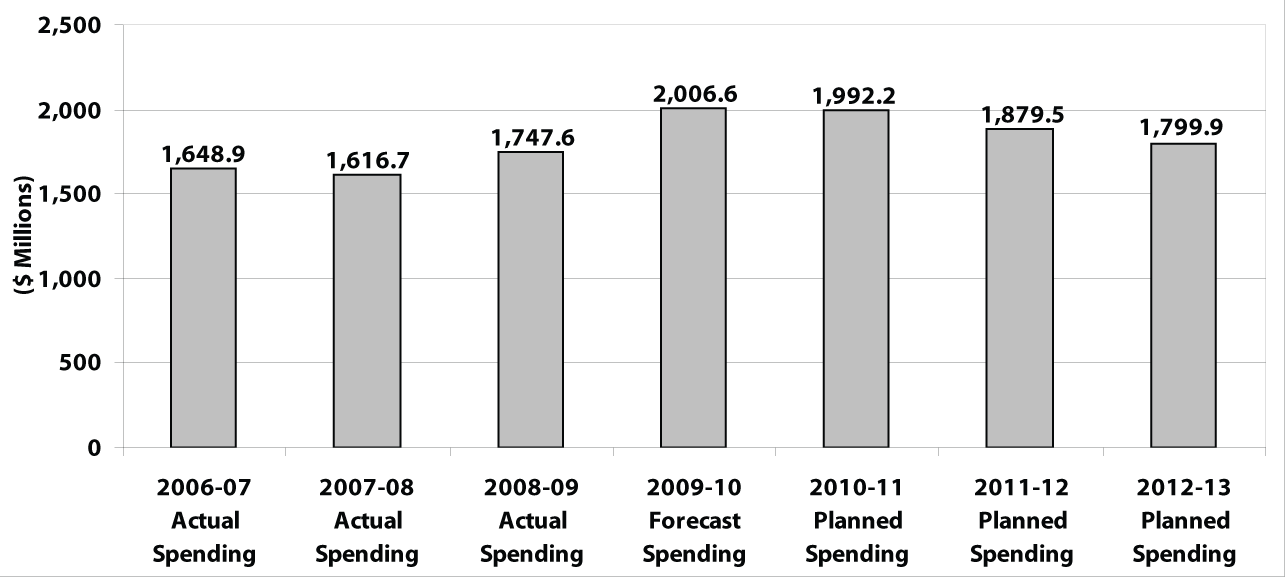
| Vote/Statutory Item | Vote/Statutory Wording | Main Estimates 2009-10 |
Main Estimates 2010-11 |
|---|---|---|---|
| 1 | Operating Expenditures | 1,167,689 | 1,283,084 |
| 5 | Capital Expenditures | 242,667 | 427,591 |
| 10 | Grants and Contributions | 110,637 | 129,231 |
| (S) | Minister of Fisheries and Oceans Canada salary and motor car allowance | 78 | 79 |
| (S) | Contributions to Employee Benefit Plans | 120,446 | 127,752 |
| Total - Fisheries and Oceans Canada | 1,641,516 | 1,967,737 | |
Human Resources Summary
DFO's most important resource is its people — the workforce of just over 11,000 employees delivers most of the Department's programs and services. The size of the workforce has remained relatively stable over the years.
DFO faces many of the same demographic challenges as the rest of the federal public service. The Department has been actively managing the impacts of an aging workforce and renewing at a time of increased technological change and complexity, globalization, challenging economic conditions, and increased diversity of Canada's population.
DFO's workforce plays both operational and scientific roles. The Department offers a wide array of challenging and interesting occupations, ranging from ship's crew at the ready for 24/7 search and rescue, to scientists researching the health of Canada's oceans, to Fishery Officers protecting fish resources and habitat, to analysts shaping policies for international fisheries issues and climate change. The Internal Services functions, which include, among others, human resources, finance, audit, communications, and information technology, enable the Department to deliver its programs and services effectively and efficiently.
DFO is highly decentralized, with 87 per cent of its workforce located outside the National Capital Region. DFO has a strong visible presence in hundreds of communities across Canada. The Coast Guard (included in the figures above) has over 4,800 employees, working in 127 locations and on 116 vessels across Canada.
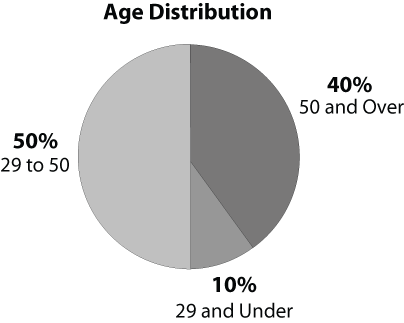
Of the DFO workforce, 90 per cent is employed on an indeterminate basis, and 10 per cent is temporary (student, casual, term, and seasonal employment). Largely because of the unique work DFO offers, particularly in scientific disciplines and CCG, employees have tended to remain with the Department well past their retirement eligibility; however, many are now deciding to leave, and the attrition rate has increased from 4 per cent in 2007 to 7 per cent in 2009. DFO has taken proactive steps to recruit and develop employees and transfer the critical knowledge necessary to maintain a stable workforce for years to come. The Department has a strong presence at public service career fairs, the Canadian Coast Guard is developing a marketing and recruitment program, and DFO is engaged in community outreach and partnerships with academia and employment equity groups.
Planning Summary by Strategic Outcome ($ Millions)
| Performance Indicator | Target |
|---|---|
| Percentage of Canadian public reporting confidence in the safety of the marine transportation system in Canada | 90% |
| Program Activity/Expected Result | Alignment to Government of Canada Outcome Areas | Forecast Spending 2009-10 |
Planned Spending | ||
|---|---|---|---|---|---|
| 2010-11 | 2011-12 | 2012-13 | |||
| Canadian Coast Guard | |||||
|
Safe and secure communities | 725.3 | 732.6 | 788.9 | 779.6 |
| Small Craft Harbours | |||||
|
Strong economic growth | 208.1 | 221.7 | 113.2 | 93.2 |
| Science for Safe and Accessible Waterways | |||||
|
Innovative and knowledge-based economy | 38.7 | 38.9 | 32.3 | 32.4 |
| Total | 972.1 | 993.2 | 934.4 | 905.2 | |
Note: Because of rounding, figures may not add to the totals shown.
| Performance Indicator | Target |
|---|---|
| Year-over-year improvement in management and conservation of major stocks to support sustainable fisheries, as evidenced in growth of the sustainability index | Baseline of 5.4/10 with target of 2% increase for 2010 to 5.5/10 and additional 2% increase to 5.6/10 for 2011 |
| Program Activity/Expected Result | Alignment to Government of Canada Outcome Areas | Forecast Spending 2009-10 |
Planned Spending | ||
|---|---|---|---|---|---|
| 2010-11 | 2011-12 | 2012-13 | |||
| Fisheries and Aquaculture Management | |||||
|
Strong economic growth | 358.0 | 350.2 | 345.9 | 305.2 |
| Science for Sustainable Fisheries and Aquaculture | |||||
|
An innovative and knowledge-based economy | 146.6 | 140.0 | 146.7 | 153.4 |
| Total | 504.6 | 490.2 | 492.5 | 458.6 | |
Note: Because of rounding, figures may not add to the totals shown.
| Performance Indicator | Target |
|---|---|
| Percentage of Canadian aquatic ecosystems where the risk to ecosystem health and productivity has been assessed as medium or low | TBD - baseline value to be measured in 2010 |
| Program Activity/Expected Result | Alignment to Government of Canada Outcome Areas | Forecast Spending 2009-10 |
Planned Spending | ||
|---|---|---|---|---|---|
| 2010-11 | 2011-12 | 2012-13 | |||
| Oceans Management | |||||
|
A clean and healthy environment | 17.2 | 15.9 | 15.3 | 13.1 |
| Habitat Management | |||||
|
A clean and healthy environment | 63.9 | 59.7 | 55.7 | 50.0 |
| Species at Risk Management | |||||
|
A clean and healthy environment | 17.3 | 23.0 | 23.7 | 14.1 |
| Science for Healthy and Productive Aquatic Ecosystems | |||||
|
An innovative and knowledge-based economy | 59.7 | 56.0 | 51.5 | 55.8 |
| Total | 158.1 | 154.7 | 146.2 | 133.0 | |
Note: Because of rounding, figures may not add to the totals shown.
| All Strategic Outcomes | Forecast Spending 2009-10 | Planned Spending | ||
|---|---|---|---|---|
| 2010-11 | 2011-12 | 2012-13 | ||
| Safe and Accessible Waterways | 972.1 | 993.2 | 934.4 | 905.2 |
| Sustainable Fisheries and Aquaculture | 504.6 | 490.2 | 492.5 | 458.6 |
| Healthy and Productive Aquatic Ecosystems | 158.1 | 154.7 | 146.2 | 133.0 |
| Internal Services | 371.9 | 354.0 | 306.3 | 303.1 |
| Total Departmental Spending | 2,006.6 | 1,992.2 | 1,879.5 | 1,799.9 |
Note: Because of rounding, figures may not add to the totals shown.
Canada's Economic Action Plan
Canada's Economic Action Plan (EAP) allocates close to $12 billion in new infrastructure funding over two years to create jobs across Canada and to ensure that Canada emerges from the economic downturn with a more modern and greener infrastructure. As part of the government's Economic Action Plan, DFO has received the following funding:
| EAP Initiative | Focus | Forecast Spending 2009-10 ($ millions) |
Planned Spending 2010-11 ($ millions) |
|---|---|---|---|
| Canadian Coast Guard — Shipbuilding and Repair |
|
90.0 | 85.0 |
| Small Craft Harbours |
|
102.3 | 97.7 |
|
7.0 | 10.0 | |
| Mackenzie Gas Project |
|
4.2 | — |
| Federal Laboratories |
|
13.6 | 24.5 |
| Federal Contaminated Sites Action Plan |
|
8.2 | 8.2 |
| Total | 225.3 | 225.4 | |
Economic Action Plan Spending
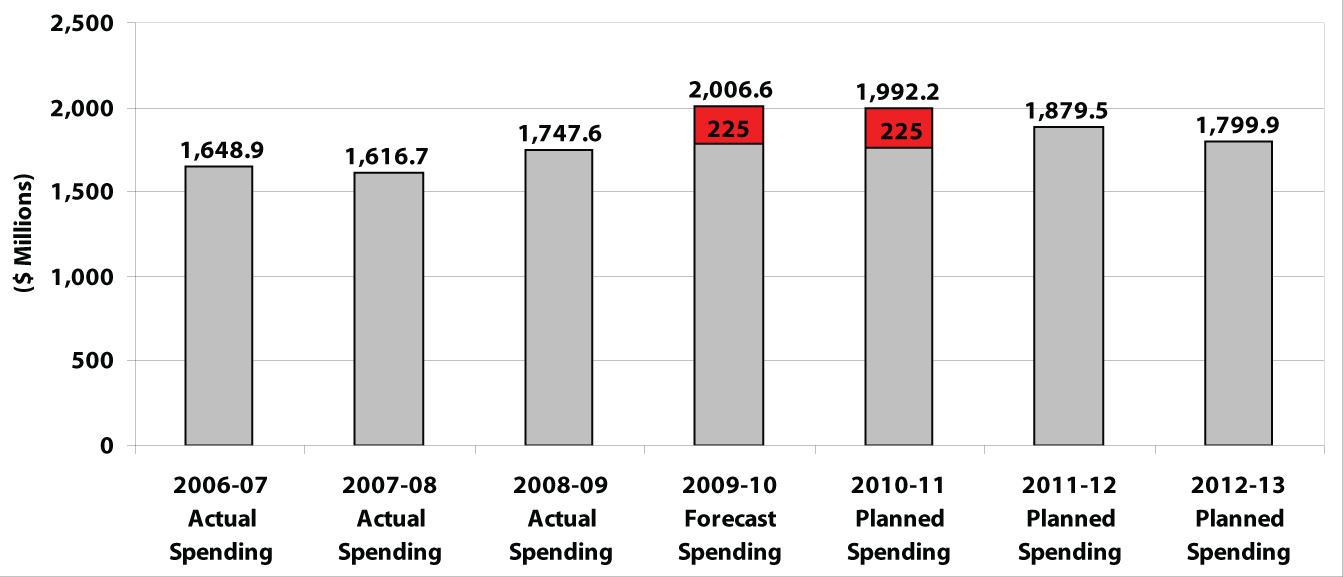
[Economic Action Plan Spending]
